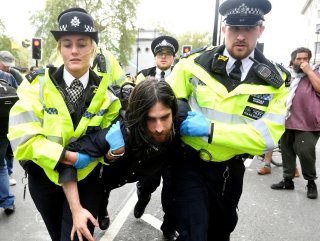The group disrupted London with 11 days of protests that it cast as the biggest act of civil disobedience in recent British history. Iconic locations were blocked, the Shell building defaced, trains stopped and Goldman Sachs targeted.
The group’s aim is clear; a rebellion against the political, economic and social structure of the modern world in time to avert the worst devastation outlined by scientists studying climate change.
1130 ARRESTS SINCE THE PROTESTS BEGAN
For the next phase of what she describes as “a movement fueled by love”, Gail Bradbrook, a co-founder of Extinction Rebellion, told Reuters she wanted to provoke a mass refusal to repay debt that would upend the financial system. “Economic growth tends to require the taking of resources from the Earth. So something has to change on a debt-based economy,” said Bradbrook, sitting in the group’s central London headquarters next to a coffin with “Our Future” written on the side.
“That would entail a mass refusal to pay off mortgages and student loans,” she said.
“Debt resistance” groups in Britain, the United States and elsewhere argue that refusing to pay debts would spark discussion about alternatives to the global economic system.
Extinction Rebellion wants non-violent civil disobedience to force governments to cut carbon emissions and avert a climate crisis it says will bring starvation and social collapse.
ENVIRONMENTAL BREAKDOWN
The group is backed by hundreds of researchers and scientists who fear that most people are unaware of the scale of the risks posed by accelerating environmental breakdown.
Police said 1,130 arrests had been made since the main protests began. A picture of a semi-nude protest in parliament went viral. One activist glued her breasts to the road outside Goldman Sachs European headquarters on Fleet Street.
